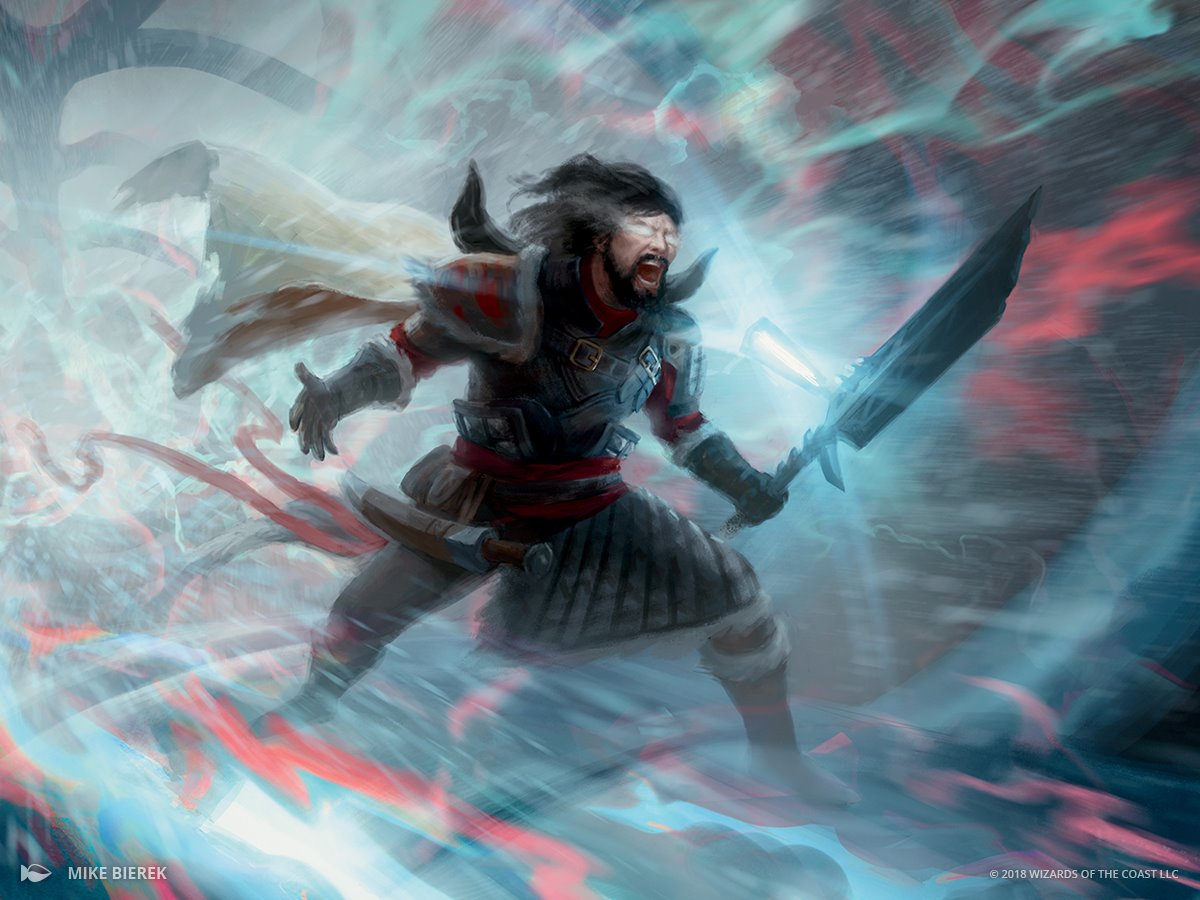Standard Disclaimer for Wizards of the Coast (WotC) employees who read this article: This article discusses business ideas to help Wizards of the Coast improve the Magic: The Gathering product. I give permission for any Wizards of the Coast employee to use the ideas contained in this article free and clear!
Wizards of the Coast (WotC) has a foil problem. To be more accurate, WotC has two foil problems. The first is the quality of foil cards being produced to the consumer. The second is the use and occurrence of foils as a chase card for Magic: The Gathering. In today’s article, I’m going to tackle the issue of the physical foil card quality. In a future article, I’ll dive into the second topic. I want to come up with some ideas and solutions, but also make this a learning experience. Along the way, we’re going to learn a bit about big box stores, marketing, and the reason why foils exist in the first place.
Before I get started, I want to say that this will be a very touchy issue. I don’t like bringing up complaints without proposing solutions. There are a lot of people who do not like foils period, or who are upset about the current quality of foil cards. I’m not looking to pile on WotC. I’m trying to explain the issues as honestly as possible and then come up with some constructive solutions.
Magic foils have always had some level of quality control issue. This is not a new problem and has been around for as long as foils have existed. This includes the original promo foil (Lightning Dragon) and the first foil set (Urza’s Legacy).
Simply put, Magic foil cards warp to some degree. This is a function of how the foil layer interacts with any amount of humidity in the air. You can learn more about that here.
Warping
Foil Magic cards are made of two things — cardboard and metal foil. Like all paper materials, Magic cards have a tiny amount of moisture within the cellulose pulp. This water is partially what gives paper flexibility without snapping it. If you remove the water, the paper becomes more brittle. If you add more water, it becomes more flexible. One way this occurs naturally is through humidity, which can cause the water content inside a card to fluctuate. It’s this fluctuation that causes cards to grow or shrink, on a virtually imperceptible scale.
With non-foil cards, this doesn’t cause a problem because the entire card expands evenly. But on foils, this can cause the cards to curl because while one side of the card is made of cardboard that changes size when water is added or removed, the other side is covered in a metal foil layer that does not expand through moisture. If you store your cards in a very humid environment, the cards will curl with the backside of the card bulging out because the backside of the card has room to expand while the front half is fixed in place by the foil layer. But if the humidity is lowered, this causes the water to go down, causing the cardboard to shrink, and the front side to bulge out.
But humidity is not the only factor that causes cards to curl. Much like how humidity causes the cardboard to grow and shrink, the same happens to the foiling when exposed to heat, because heat causes the metal to expand, and lower temperatures cause it to contract. These two factors control how much a card warps. If the temperature and humidity are at the temperature the cards were printed at, they won’t curl. If you keep your cards in a super-dry environment and under a lot of heat, you’re going to get extreme curling. Keep them super-cold and damp, and you’ll get extreme curling in the other direction.
From day one, players were cautioned about using foil cards judiciously in tournament play. This includes people using all foil lands / no other foil cards (marked cards), only foil versions of a couple of key cards in their deck (marked cards), and being able to pick out foil cards on the top of your deck due to feel / warping, even through sleeves (marked cards). Even if these foils were not marked intentionally, it still caused tournament players to shy away from playing decks that were anything but all-foil in case of unintentional cheating.
The pinnacle of the issue with foil cards in tournament play can be encapsulated by Nexus of Fate. Printed only in foil, this Buy-a-Box promo became one of the most played Standard cards. If a player wanted to play Nexus of Fate, they had one of three choices:
- Foil their entire deck
- Get a judge to proxy the card with a non-foil basic land
- Risk getting tournament penalties for playing with a marked deck (since Nexus of Fate would eventually warp)
Needless to say, it was not a good look when Magic tournament judges have to say implicitly that you cannot play with a certain card in your deck (without being proxied) because of physical quality control issues on said card. This came to a head at Pro Tour 25th Anniversary, where the deck featured heavily in the metagame and a large number of Nexus cards had to be proxied — at the highest level of exposure for the game of Magic.
In more recent years, the quality of foils bending has seemingly gotten worse. I don’t have empirical evidence that anything has changed with the manufacturing process to create foil cards. Unfortunately, all anecdotal evidence points to foil warping being the expected norm, to the point where people are commonly referring to foil cards as Pringles, the most famous hyperbolic paraboloid on the planet. This seems to have reached an apex (or nadir!) with Commander Legends.
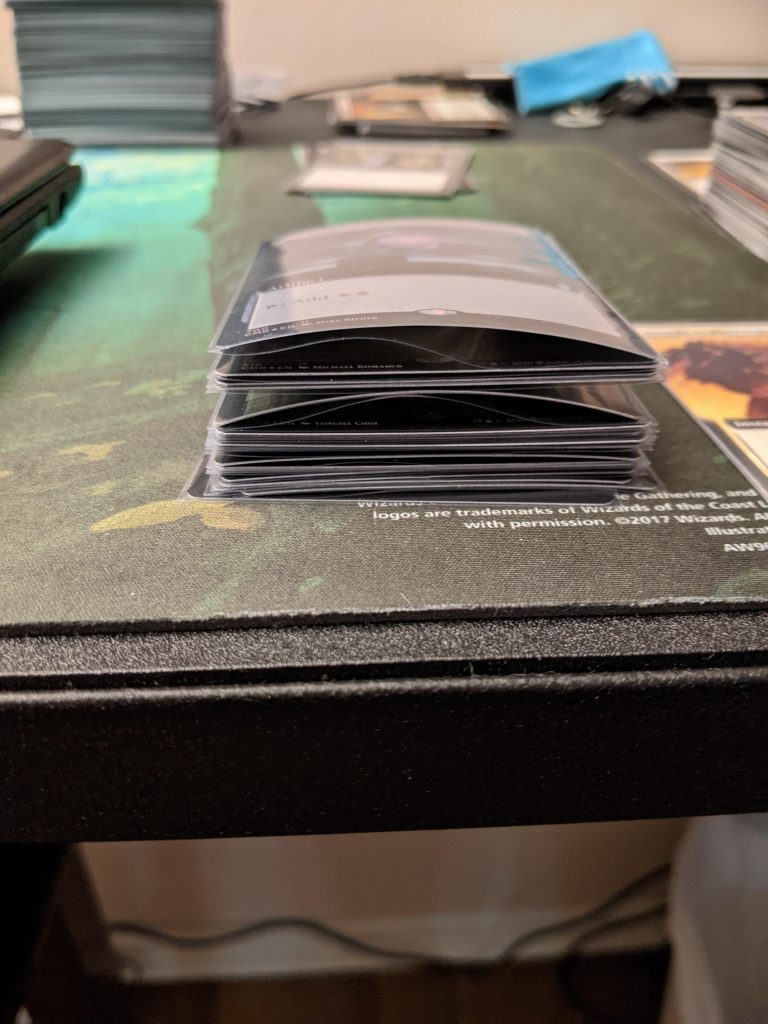
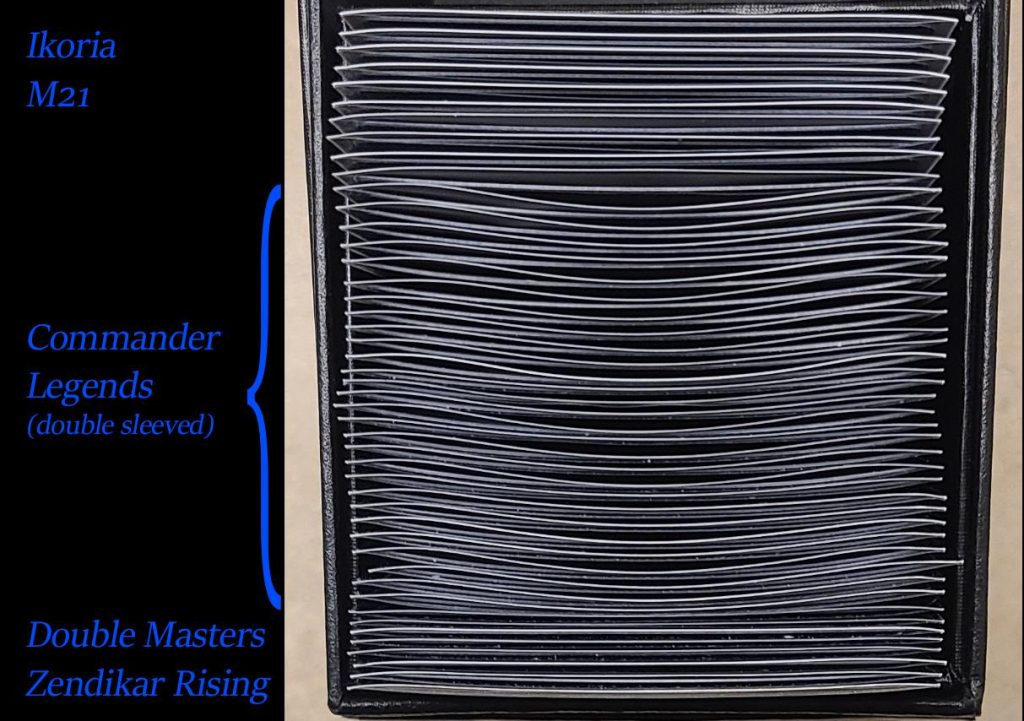
Let’s explore how WotC can make foils less prone to warping and more playable out of the pack. I’m going to assume it’s not as easy as saying “fix the foil process” because believe me — WotC would have snapped their fingers and done that if that were possible. WotC has tried at least a half-dozen different foil treatment of cards. They are trying but assuredly are not succeeding as of yet. So in lieu of “higher quality” (which I’m not sure can be done, due to why foils warp to begin with), let’s look at some possible solutions.
Solution #1: Change the way foil cards are foiled.
There have been several experiments to the foiling process over the years. This includes etched foils, changing the foil process at 8th Edition, From the Vault foiling, Masterpiece Series foiling, and San Diego Comic-Con foiling. None of these have fully solved the foil curling issue. This is an issue that other games have and is not exclusive to Magic. You can Google tons of examples of curling foils for Pokémon.
However, only the fully foiled Pokemon cards have these issues. Pokemon cards that only foil the art box (both regular and reverse foils) and most Yu-Gi-Oh cards (only art box is foil) don’t have these issues. There’s a run of Masterpiece Series cards (Kaladesh Inventions) that were foiled differently between the American printing and the European printing; here’s a full write-up about the differences.
Long story short, the European versions (printed at the Belgium plant) had much, much less curling than the American versions had (printed in the USA). A lot of the solution was strategically using the foiling only on parts of the card and using a matte finish on the card, versus the normal foiling process used on most Magic sets.
The key strategy here would be making it so that the entirety of a card was not foiled in order to prevent the types of warping we’ve seen now. Maybe only the art and text boxes would be foiled. It could only be the art box or strategic patterns on the borders. Maybe you can even do the inverse for special border treatments. For example, imagine if only the green frames / card name and the Phyrexian watermark were foiled for Vorinclex, Monstrous Raider (Showcase frame). That’s a foil treatment that would really pop, and I’d even argue that “less is more” here. Having only the frame of this card foiled would make the artwork stand out that much more versus “Hey, it’s all foil!”
Solution #2: Foil both sides of the card.
Double-sided foil cards are less prone to any sort of warping compared to single-sided foil cards. The reason is the same reason why foils cause curling in the first place (humidity and shrinkage). If both sides of the card are being equally affected, the card as a whole is less likely to turn concave in any one direction.
The solution here would be for WotC to start foiling both sides of foil Magic cards, even if the back side of the card is the normal Magic back. While this would cause issues if people were playing in tournaments without sleeves, it’s really not different from how people have to handle double-sided cards in tournament play right now.
We’ve even gotten to the point where WotC is releasing “make your own token” cards in major Magic releases. This would be right at home for people who want to “officially proxy” a foil card in a Sealed pool. Either way, my guess is that a double-sided foil card in a sleeve is less marked than a single-sided foil card in a sleeve, as they currently exist.
Solution #3: Do away with foils.
The amount of players who care about foil cards in general is very, very small compared to the overall pool of Magic players. The majority of players (and I’m talking 90%+ based on decades of shopping data) want one of the two following when buying a card for their deck:
- The cheapest Near Mint version available
- The cheapest tournament-playable version available
Almost by default, foil cards never fall into one of these two categories unless there’s only a foil printing of that card! Due to perceived and actual value, the foil version of a card is almost always going to be more expensive than the non-foil version.
In a vacuum, and based solely on spending habits, the average player would rather pay $3 for a non-foil version of a card than $4 for a foil version. Again, the main reason is just that $1 savings. The secondary reason is all of the problems with foil cards being marked that I’ve touched upon in the rest of this article.
I’m sure there are other ways to fix foil cards that I haven’t touched on, but many of them would involve overhauling the entire printing and manufacturing of Magic cards as a brand. In the end, I don’t think that many of these solutions are going to work for Hasbro. The demand for Magic cards is there, and WotC has to have taken notice of the dramatic increase in issues with foil warping over the past couple of years. It doesn’t do them any good if their supposed “chase” cards are viewed as being inherently damaged out of the pack.
With that said, there is no way that WotC is going to stop printing foil cards entirely. That’s different from the thought of “Should WotC stop printing foil cards entirely?” A lot of this comes down to marketing, perceived value, and collectibility.
For the people who have these stores in their countries — have you ever walked into a Target or Walmart and taken a look at their card section? There are dozens of different games and cards vying for shelf space. The big ones right now are Pokémon and Magic, but there are still displays of Yu-Gi-Oh! cards, sports cards, mini figurines for the franchise of the day (Five Nights at Freddy’s / Fortnite / Roblox).
Big box store sales make up a significant amount of Magic’s sales figures. The educated estimates I’ve heard is that between 20% and 40% of all sealed sales are made at these types of stores. Do not take this to be absolute knowledge please! Nobody outside of WotC knows the true figure. However, napkin math shows the following:
There are 4,756 Walmart stores in the United States. There are 1,868 Target stores in the United States. Let’s say that each store gets one case of product of each Draft Booster release. This accounts for 6,624 cases of product every set release, or 39,744 boxes of product. And this is just Draft Boosters. I’ve seen theme decks, bundles, collector packs, set boosters, and most ancillary products at these stores.
The one-case-a-store scenario is probably low. There are other big box stores that carry Magic (GameStop, Meijer, Barnes & Noble, Walgreens, etc.). The point is that when you start adding up all of these stores across all these releases, you can see where the 20%-40% figure starts coming into view.
The one thing that all of these stores have in common is that Magic needs to compete for shelf space. If the product isn’t selling, the stores are going to stop carrying the product. So then we look at the customers who are buying cards at a Walmart or Target. I’d group the primary Big Box Store Magic customer into one of five demographics. Full acknowledgement that there are other reasons why people would purchase cards at a big box store, but most entrenched players are going to either buy online or through their LGS.
- People who don’t have ready access to the Internet / do not attend a LGS to pick up cards. I’d put younger children who are either buying cards for themselves or having their parents buy cards for them into this category.
- Extremely casual players who are not entrenched in the game. These are people who have access to the Internet, but are playing with some friends at the kitchen table and haven’t really looked online / are just buying packs casually here and there. This also includes people who are looking to try a new game for the first time, and decide to give their first pack of MTG a shot.
- People buying cards as presents for someone else. Very easy to just walk into a Walmart or Target when you’re doing a shopping trip, see the MTG display, and think, “Hey, my friend’s birthday is coming up! I bet they’d love this Kaldheim Bundle! Let me just grab it while I’m here!” This also overlaps with #1 – people buying cards for kids (but as presents).
- Players who can’t get cards at other locations. Walmart is notorious for breaking the street date on products, and so there have been countless reports over the years of players being able to get their hands on products earlier than release date. This goes for all TCGs (not just Magic). Big box stores also tend to be full MSRP on these products, and Internet purchases / LGS prices are almost always cheaper. There are instances where a product sells out almost instantly at the LGS/Internet level and shoots straight above MSRP due to demand. Two recent examples include Throne of Eldraine Brawl decks and the first wave of Jumpstart. In these cases, Walmart/Target and full MSRP look like a good deal.
- People who see a sale. A lot of these stores clear out product that hasn’t sold within X period of time to make room for the new hotness. This is when you start seeing “buy one, get one free” sales at your local GameStop.
Again – there are other reasons people will buy at big box (they have gift cards to spend / genuine impulse purchase for an enfranchised player), but the above five reasons are the big ones. And what the three biggest ones have in common (buying as presents / non-enfranchised players / very casual players) is that the product must differentiate itself on a visual level.
If you’re looking to try a card game for the first time, what looks more impressive? This:
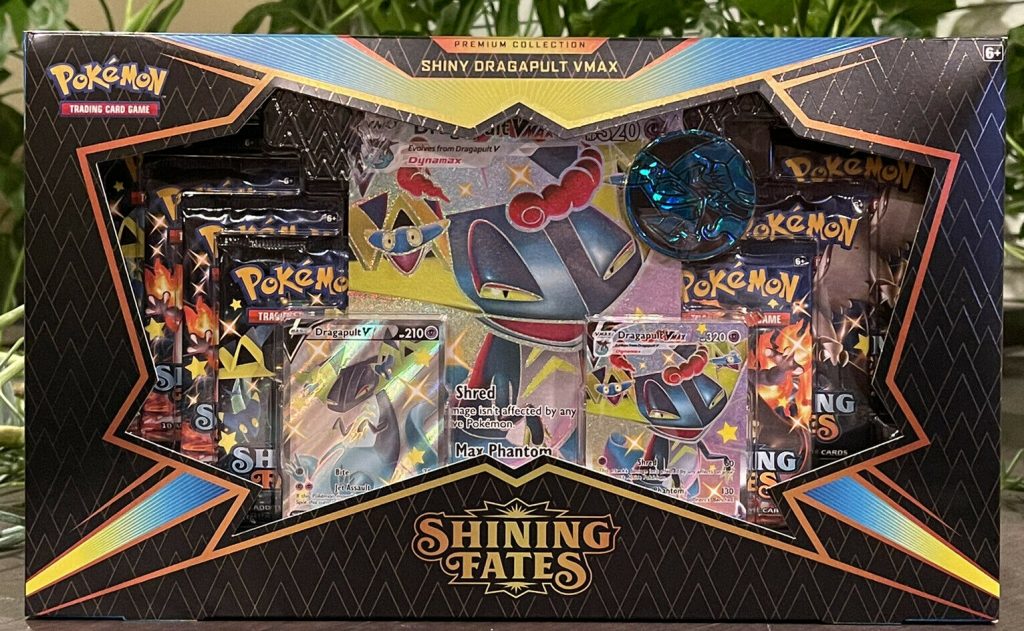
Or this?
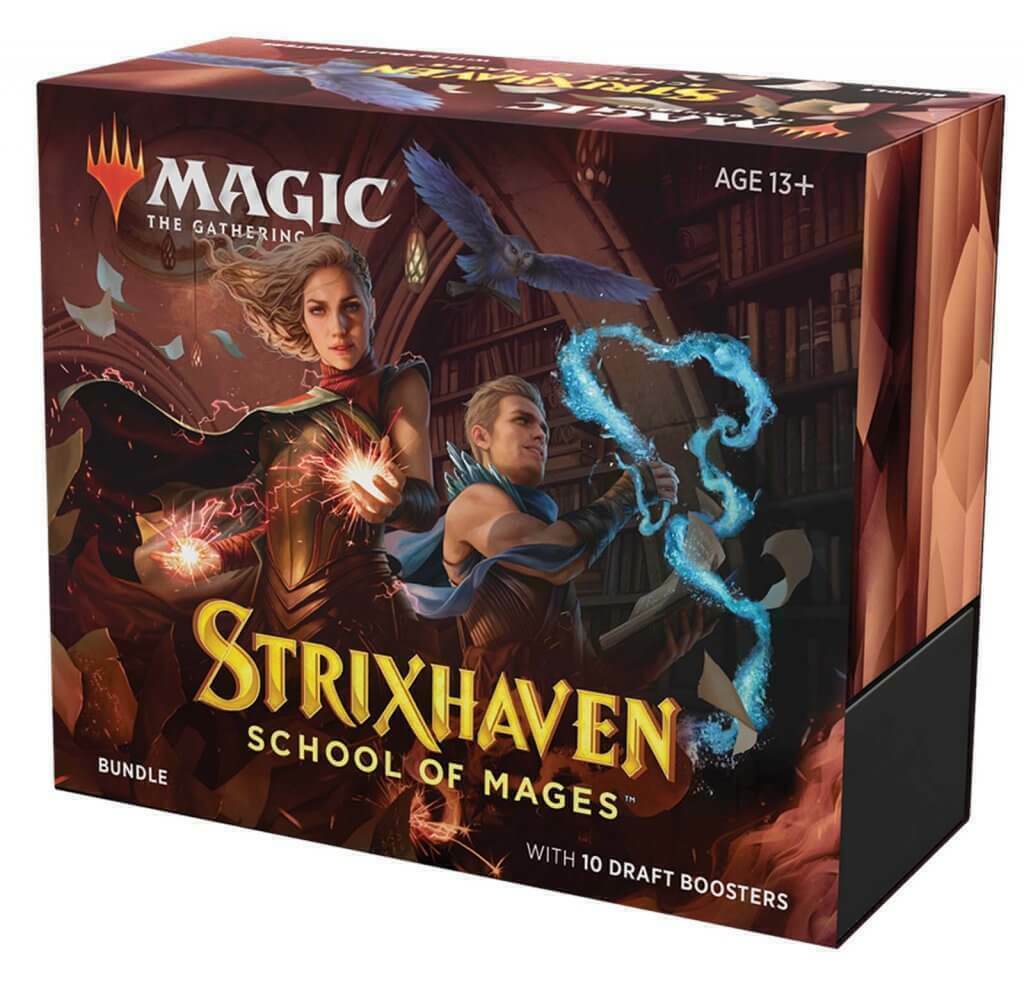
In a vacuum, the Pokémon packaging looks a lot more attractive. You can see the packs you’re getting through the packaging. There are multiple foil promotional cards right there, in your face. There’s even a giant-sized Dragapult VMAX card front and center!
By contrast, the Strixhaven box artwork is pretty awesome, but it doesn’t really show you the product. If you aren’t an enfranchised player, you have no clue what comes in the box just at a glance. Yes, there’s information on the front and back, but we’re talking what catches the eye / getting someone to make their first purchase just on looks alone. “With 10 Draft Boosters” doesn’t mean anything to someone who has never played Magic before. By contrast, you can see the packs visually on the Shining Fates packaging, as well as two of the actual gameplay cards.
Where WotC has done a lot better is with Commander Deck packaging. Let’s look at a Commander 2020 deck:
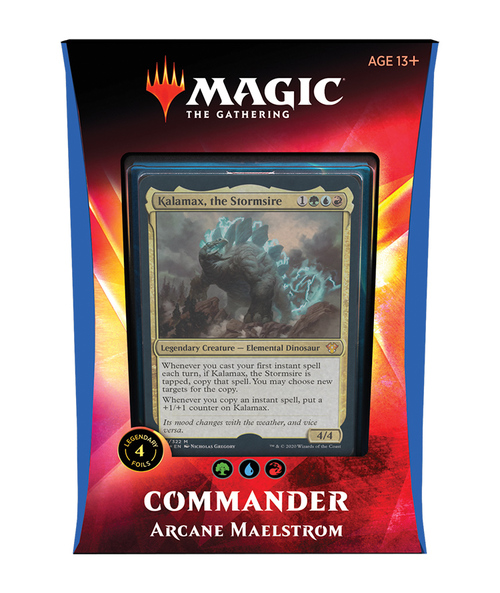
While the front of the box still doesn’t give you as much information as I’d like to see (Includes 100 cards! Fully built deck! Play out of the box!), the visual of an actual Magic card is a huge step forward over the bundle packaging. It draws the eye and gives more of a chance that someone will pick up the packaging and look at the back of the box (where that extra information is contained).
And so here’s the rub — WotC needs some sort of card they can display that visually competes with other products at the big box level. Virtually all successful TCGs have some sort of shiny version of a card that they can tout in this type of retail space. Getting rid of foils entirely would be viable if this were purely from a gameplay standpoint, or even from a “this is what sells singles” standpoint. But when push comes to shove, cutting out foils from Magic in all forms would be WotC kneecapping themselves at 20%-40% of the product they sell. Suffice it to say, that would not be a good corporate decision.
My personal preference for a solution would be the first option I listed — changing cards so that only key portions of the card are foiled. This would still allow the cards to stand out, would reduce the chance an amount that card warped, and would look better than how foils look now on any sort of different frame treatment. While foiling both sides of a Magic card might work (they have been proven to warp less), the unintended side effect is that foil cards would be even harder to keep in Near Mint condition. Foil Magic cards tend to scratch/wear more easily than non-foil Magic cards, and now we’d be looking at more damage-prone cards for both the front and the back of foil cards.
I can also make an extremely strong argument for a modified version of the nuclear option — getting rid of foil cards entirely. For the reasons stated above, I do believe that some form of foil card needs to exist for display purposes at the retail level. I also think that foils now are being horribly misused as a sales driver of Magic cards.
I’ll be taking the next three weeks to do my Strixhaven Financial Review — Part 1 is coming Monday! Once those are done, I’ll have an article that will transform the way that you view foil cards as a part of the Magic ecosystem!

